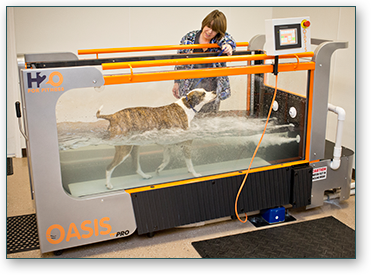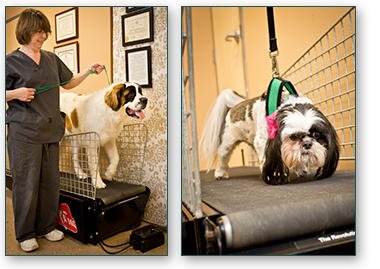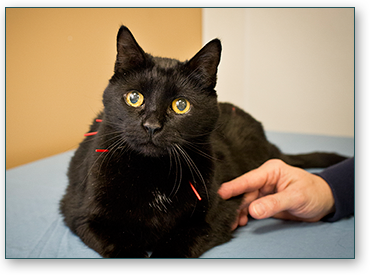Home
|
About Dr. Ballengee
|
Our Services
|
FAQ
|
Testimonials
|
Contact Us
Our Services
Pawsitive Steps Pet Rehab Clinic is proud to be at the forefront of veterinary rehabilitation in North Carolina. We use a mixture of traditional exercise therapies and state-of-the-art techniques to ensure that animals achieve the greatest possible mobility and least pain.
Disclaimer: While a lot of these tools may be common and you may have them at home, please don't try to do pet rehab yourself. Pet rehabilitation therapy requires expert knowledge of animal physiology!
Some of the tools and techniques we use include:
 |
Hydrotherapy via Underwater TreadmillHydrotherapy is one of the most powerful therapy options available to us – warm water decreases pain, soothes aches, and encourages blood flow, while the buoyancy of the water supports animals' weight, taking pressure off uncomfortable joints or bones. We are one of the few practices in central North Carolina that has an on-site underwater treadmill equipped with jets and an adjustable incline to vary and intensify workouts. Common Reasons for Hydrotherapy: Improve strength, muscular and cardiovascular endurance, range of motion, and balance |
 |
Land TreadmillWe use a treadmill adapted especially for pets of all sizes, and it's used in much the same way people use treadmills: to encourage strength and build endurance. Common Reasons for Using a Land Treadmill: Improve strength, balance, and proprioception |
 |
AcupunctureAcupuncture – inserting tiny needles into specific points in the body to reduce pain and encourage healing – has been used to treat animals (and people) in China for thousands of years. While it has been far less common in Western veterinary medicine, today's veterinary professionals are increasingly likely to recommend acupuncture for its therapeutic effects. Acupuncture helps the body heal itself! It works by stimulating the body's natural healing mechanisms – endogenous painkillers, anti-inflammatory responses and immune activities. Common Reasons We Use Acupuncture: Decrease need for medications, reduce pain, and improve neuromuscular functioning |
Therapeutic Exercise
Many people are surprised that animals use exercise equipment that looks a lot like what they see at their local gym, but it's just as effective for dogs and cats as it is for people. At our practice, you'll see exercise balls, therabands, wobble boards, Cavalletti rails, and other tools for helping your pet gain strength, balance, and endurance.
Common Reasons for Therapeutic Exercise:
Therapeutic exercise is important in all cases: It is the cornerstone of all physical activity!
Therapeutic Exercise Goals:
Improve muscle mass and strength, range of motion, balance, daily functioning, and conditioning; prevent injury; and reduce weight and lameness

Thermotherapy
If you've ever pulled a muscle or had a sprain, you're probably familiar with the technique of alternating ice and heat to encourage healing. Cold and heat thermotherapy complements exercise and other rehabilitation techniques for animals, too. Cooling injured joints or muscles – cryotherapy - reduces swelling and pain caused by inflammation. Gently heating an injured area – thermotherapy - can increase range of motion, increase blood flow, and prevent new injury or re-injury.
Common Reasons We Use Superficial Heat/Cold:
Reduce pain and improve tissue healing and joint movement
Electrical Stimulation
Not found routinely outside of rehabilitation clinics, electrical stimulation is an excellent tool in preventing muscle atrophy, developing muscle strength, and relieving pain in animals. Electrical stimulation involves applying low-level electrical currents to a muscle that has been injured or weakened, stimulating the muscle, forcing it to contract. This essentially helps ‘re-train' the muscle, improving its function and speeding the healing process.
Common Reasons We Use Electrical Stimulation:
Prevent/reverse muscle atrophy; improve muscle strength; and reduce pain, spasms, and edema
Fitting for Assistive Devices (carts, braces, etc.)
Splints, braces, carts, and other assistive equipment can be used to support injured limbs during healing, encourage correct limb use, substitute for a missing limb, or enable movement in paralyzed animals. When appropriate, we will evaluate your pet to determine what assistive devices may be beneficial, fit your pet for the appropriate device, and train you in effective use of the equipment.
Common Reasons We Use Assistive Devices:
Improve mobility, minimize injury, and protect tissues
Laser Therapy
A non-invasive treatment, laser therapy uses light energy to modulate cell activity. Through cellular photobiostimulation, protein synthesis and metabolism are increased, improving cell health and function. Laser therapy also stimulates the immune system, releases natural endorphins, and decreases inflammatory mediators. Ultimately, therapeutic lasers have the ability to accelerate tissue repair and cell growth in body tissues such as skin, tendons, ligaments, and muscles…and relieve pain. They may be used alone or in combination with other rehabilitative modalities.
Common Reasons We Use Laser Therapy:
Reduce joint and soft tissue pain, decrease inflammation and edema (swelling), increase circulation, and accelerate tissue healing
